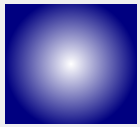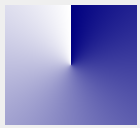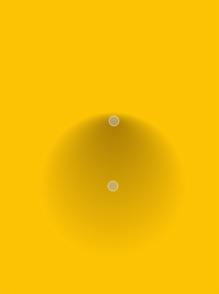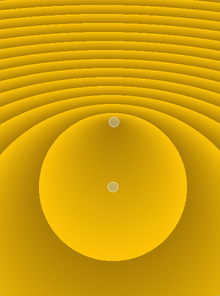#[repr(C)]pub struct QGradient { /* private fields */ }Expand description
The QGradient class is used in combination with QBrush to specify gradient fills.
C++ class: QGradient.
The QGradient class is used in combination with QBrush to specify gradient fills.
Qt currently supports three types of gradient fills:
- Linear gradients interpolate colors between start and end points.
- Simple radial gradients interpolate colors between a focal point and end points on a circle surrounding it.
- Extended radial gradients interpolate colors between a center and a focal circle.
- Conical gradients interpolate colors around a center point.
A gradient's type can be retrieved using the type() function. Each of the types is represented by a subclass of QGradient:
The colors in a gradient are defined using stop points of the QGradientStop type; i.e., a position and a color. Use the setColorAt() function to define a single stop point. Alternatively, use the setStops() function to define several stop points in one go. Note that the latter function replaces the current set of stop points.
It is the gradient's complete set of stop points (accessible through the stops() function) that describes how the gradient area should be filled. If no stop points have been specified, a gradient of black at 0 to white at 1 is used.
A diagonal linear gradient from black at (100, 100) to white at (200, 200) could be specified like this:
QLinearGradient linearGrad(QPointF(100, 100), QPointF(200, 200)); linearGrad.setColorAt(0, Qt::black); linearGrad.setColorAt(1, Qt::white);
A gradient can have an arbitrary number of stop points. The following would create a radial gradient starting with red in the center, blue and then green on the edges:
QRadialGradient radialGrad(QPointF(100, 100), 100); radialGrad.setColorAt(0, Qt::red); radialGrad.setColorAt(0.5, Qt::blue); radialGrad.setColorAt(1, Qt::green);
It is possible to repeat or reflect the gradient outside its area by specifiying the spread method using the setSpread() function. The default is to pad the outside area with the color at the closest stop point. The currently set spread method can be retrieved using the spread() function. The QGradient::Spread enum defines three different methods:
Note that the setSpread() function only has effect for linear and radial gradients. The reason is that the conical gradient is closed by definition, i.e. the conical gradient fills the entire circle from 0 - 360 degrees, while the boundary of a radial or a linear gradient can be specified through its radius or final stop points, respectively.
The gradient coordinates can be specified in logical coordinates, relative to device coordinates, or relative to object bounding box coordinates. The coordinate mode can be set using the setCoordinateMode() function. The default is LogicalMode, where the gradient coordinates are specified in the same way as the object coordinates. To retrieve the currently set coordinate mode use coordinateMode().
Implementations§
source§impl QGradient
impl QGradient
sourcepub unsafe fn coordinate_mode(&self) -> CoordinateMode
pub unsafe fn coordinate_mode(&self) -> CoordinateMode
Returns the coordinate mode of this gradient. The default mode is LogicalMode.
Calls C++ function: QGradient::CoordinateMode QGradient::coordinateMode() const.
Returns the coordinate mode of this gradient. The default mode is LogicalMode.
This function was introduced in Qt 4.4.
See also setCoordinateMode().
sourcepub unsafe fn copy_from(
&self,
other: impl CastInto<Ref<QGradient>>
) -> Ref<QGradient>
pub unsafe fn copy_from( &self, other: impl CastInto<Ref<QGradient>> ) -> Ref<QGradient>
The QGradient class is used in combination with QBrush to specify gradient fills.
Calls C++ function: QGradient& QGradient::operator=(const QGradient& other).
The QGradient class is used in combination with QBrush to specify gradient fills.
Qt currently supports three types of gradient fills:
- Linear gradients interpolate colors between start and end points.
- Simple radial gradients interpolate colors between a focal point and end points on a circle surrounding it.
- Extended radial gradients interpolate colors between a center and a focal circle.
- Conical gradients interpolate colors around a center point.
A gradient's type can be retrieved using the type() function. Each of the types is represented by a subclass of QGradient:
The colors in a gradient are defined using stop points of the QGradientStop type; i.e., a position and a color. Use the setColorAt() function to define a single stop point. Alternatively, use the setStops() function to define several stop points in one go. Note that the latter function replaces the current set of stop points.
It is the gradient's complete set of stop points (accessible through the stops() function) that describes how the gradient area should be filled. If no stop points have been specified, a gradient of black at 0 to white at 1 is used.
A diagonal linear gradient from black at (100, 100) to white at (200, 200) could be specified like this:
QLinearGradient linearGrad(QPointF(100, 100), QPointF(200, 200)); linearGrad.setColorAt(0, Qt::black); linearGrad.setColorAt(1, Qt::white);
A gradient can have an arbitrary number of stop points. The following would create a radial gradient starting with red in the center, blue and then green on the edges:
QRadialGradient radialGrad(QPointF(100, 100), 100); radialGrad.setColorAt(0, Qt::red); radialGrad.setColorAt(0.5, Qt::blue); radialGrad.setColorAt(1, Qt::green);
It is possible to repeat or reflect the gradient outside its area by specifiying the spread method using the setSpread() function. The default is to pad the outside area with the color at the closest stop point. The currently set spread method can be retrieved using the spread() function. The QGradient::Spread enum defines three different methods:
Note that the setSpread() function only has effect for linear and radial gradients. The reason is that the conical gradient is closed by definition, i.e. the conical gradient fills the entire circle from 0 - 360 degrees, while the boundary of a radial or a linear gradient can be specified through its radius or final stop points, respectively.
The gradient coordinates can be specified in logical coordinates, relative to device coordinates, or relative to object bounding box coordinates. The coordinate mode can be set using the setCoordinateMode() function. The default is LogicalMode, where the gradient coordinates are specified in the same way as the object coordinates. To retrieve the currently set coordinate mode use coordinateMode().
sourcepub unsafe fn interpolation_mode(&self) -> InterpolationMode
pub unsafe fn interpolation_mode(&self) -> InterpolationMode
Calls C++ function: QGradient::InterpolationMode QGradient::interpolationMode() const.
sourcepub unsafe fn new_0a() -> CppBox<QGradient>
pub unsafe fn new_0a() -> CppBox<QGradient>
Constructs a gradient based on a predefined preset.
Calls C++ function: [constructor] void QGradient::QGradient().
Warning: no exact match found in C++ documentation. Below is the C++ documentation for QGradient::QGradient(QGradient::Preset preset):
Constructs a gradient based on a predefined preset.
The coordinate mode of the resulting gradient is QGradient::ObjectMode, allowing the preset to be applied to arbitrary object sizes.
This function was introduced in Qt 5.12.
sourcepub unsafe fn new_1a(arg1: Preset) -> CppBox<QGradient>
Available on cpp_lib_version="5.12.2" or cpp_lib_version="5.13.0" or cpp_lib_version="5.14.0" only.
pub unsafe fn new_1a(arg1: Preset) -> CppBox<QGradient>
cpp_lib_version="5.12.2" or cpp_lib_version="5.13.0" or cpp_lib_version="5.14.0" only.Constructs a gradient based on a predefined preset.
Calls C++ function: [constructor] void QGradient::QGradient(QGradient::Preset arg1).
Constructs a gradient based on a predefined preset.
The coordinate mode of the resulting gradient is QGradient::ObjectMode, allowing the preset to be applied to arbitrary object sizes.
This function was introduced in Qt 5.12.
sourcepub unsafe fn new_copy(
other: impl CastInto<Ref<QGradient>>
) -> CppBox<QGradient>
pub unsafe fn new_copy( other: impl CastInto<Ref<QGradient>> ) -> CppBox<QGradient>
The QGradient class is used in combination with QBrush to specify gradient fills.
Calls C++ function: [constructor] void QGradient::QGradient(const QGradient& other).
The QGradient class is used in combination with QBrush to specify gradient fills.
Qt currently supports three types of gradient fills:
- Linear gradients interpolate colors between start and end points.
- Simple radial gradients interpolate colors between a focal point and end points on a circle surrounding it.
- Extended radial gradients interpolate colors between a center and a focal circle.
- Conical gradients interpolate colors around a center point.
A gradient's type can be retrieved using the type() function. Each of the types is represented by a subclass of QGradient:
The colors in a gradient are defined using stop points of the QGradientStop type; i.e., a position and a color. Use the setColorAt() function to define a single stop point. Alternatively, use the setStops() function to define several stop points in one go. Note that the latter function replaces the current set of stop points.
It is the gradient's complete set of stop points (accessible through the stops() function) that describes how the gradient area should be filled. If no stop points have been specified, a gradient of black at 0 to white at 1 is used.
A diagonal linear gradient from black at (100, 100) to white at (200, 200) could be specified like this:
QLinearGradient linearGrad(QPointF(100, 100), QPointF(200, 200)); linearGrad.setColorAt(0, Qt::black); linearGrad.setColorAt(1, Qt::white);
A gradient can have an arbitrary number of stop points. The following would create a radial gradient starting with red in the center, blue and then green on the edges:
QRadialGradient radialGrad(QPointF(100, 100), 100); radialGrad.setColorAt(0, Qt::red); radialGrad.setColorAt(0.5, Qt::blue); radialGrad.setColorAt(1, Qt::green);
It is possible to repeat or reflect the gradient outside its area by specifiying the spread method using the setSpread() function. The default is to pad the outside area with the color at the closest stop point. The currently set spread method can be retrieved using the spread() function. The QGradient::Spread enum defines three different methods:
Note that the setSpread() function only has effect for linear and radial gradients. The reason is that the conical gradient is closed by definition, i.e. the conical gradient fills the entire circle from 0 - 360 degrees, while the boundary of a radial or a linear gradient can be specified through its radius or final stop points, respectively.
The gradient coordinates can be specified in logical coordinates, relative to device coordinates, or relative to object bounding box coordinates. The coordinate mode can be set using the setCoordinateMode() function. The default is LogicalMode, where the gradient coordinates are specified in the same way as the object coordinates. To retrieve the currently set coordinate mode use coordinateMode().
sourcepub unsafe fn set_color_at(
&self,
pos: c_double,
color: impl CastInto<Ref<QColor>>
)
pub unsafe fn set_color_at( &self, pos: c_double, color: impl CastInto<Ref<QColor>> )
Creates a stop point at the given position with the given color. The given position must be in the range 0 to 1.
Calls C++ function: void QGradient::setColorAt(double pos, const QColor& color).
sourcepub unsafe fn set_coordinate_mode(&self, mode: CoordinateMode)
pub unsafe fn set_coordinate_mode(&self, mode: CoordinateMode)
Sets the coordinate mode of this gradient to mode. The default mode is LogicalMode.
Calls C++ function: void QGradient::setCoordinateMode(QGradient::CoordinateMode mode).
Sets the coordinate mode of this gradient to mode. The default mode is LogicalMode.
This function was introduced in Qt 4.4.
See also coordinateMode().
sourcepub unsafe fn set_interpolation_mode(&self, mode: InterpolationMode)
pub unsafe fn set_interpolation_mode(&self, mode: InterpolationMode)
Calls C++ function: void QGradient::setInterpolationMode(QGradient::InterpolationMode mode).
sourcepub unsafe fn set_spread(&self, spread: Spread)
pub unsafe fn set_spread(&self, spread: Spread)
Specifies the spread method that should be used for this gradient.
Calls C++ function: void QGradient::setSpread(QGradient::Spread spread).
Specifies the spread method that should be used for this gradient.
Note that this function only has effect for linear and radial gradients.
See also spread().
sourcepub unsafe fn set_stops(
&self,
stops: impl CastInto<Ref<QVectorOfQPairOfDoubleQColor>>
)
pub unsafe fn set_stops( &self, stops: impl CastInto<Ref<QVectorOfQPairOfDoubleQColor>> )
Replaces the current set of stop points with the given stopPoints. The positions of the points must be in the range 0 to 1, and must be sorted with the lowest point first.
Calls C++ function: void QGradient::setStops(const QVector<QPair<double, QColor>>& stops).
Replaces the current set of stop points with the given stopPoints. The positions of the points must be in the range 0 to 1, and must be sorted with the lowest point first.
See also setColorAt() and stops().
sourcepub unsafe fn spread(&self) -> Spread
pub unsafe fn spread(&self) -> Spread
Returns the spread method use by this gradient. The default is PadSpread.
Calls C++ function: QGradient::Spread QGradient::spread() const.
sourcepub unsafe fn static_meta_object() -> Ref<QMetaObject>
pub unsafe fn static_meta_object() -> Ref<QMetaObject>
Returns a reference to the staticMetaObject field.
sourcepub unsafe fn stops(&self) -> CppBox<QVectorOfQPairOfDoubleQColor>
pub unsafe fn stops(&self) -> CppBox<QVectorOfQPairOfDoubleQColor>
Returns the stop points for this gradient.
Calls C++ function: QVector<QPair<double, QColor>> QGradient::stops() const.
Returns the stop points for this gradient.
If no stop points have been specified, a gradient of black at 0 to white at 1 is used.
See also setStops() and setColorAt().
Trait Implementations§
source§impl CppDeletable for QGradient
impl CppDeletable for QGradient
source§unsafe fn delete(&self)
unsafe fn delete(&self)
The QGradient class is used in combination with QBrush to specify gradient fills.
Calls C++ function: [destructor] void QGradient::~QGradient().
The QGradient class is used in combination with QBrush to specify gradient fills.
Qt currently supports three types of gradient fills:
- Linear gradients interpolate colors between start and end points.
- Simple radial gradients interpolate colors between a focal point and end points on a circle surrounding it.
- Extended radial gradients interpolate colors between a center and a focal circle.
- Conical gradients interpolate colors around a center point.
A gradient's type can be retrieved using the type() function. Each of the types is represented by a subclass of QGradient:
The colors in a gradient are defined using stop points of the QGradientStop type; i.e., a position and a color. Use the setColorAt() function to define a single stop point. Alternatively, use the setStops() function to define several stop points in one go. Note that the latter function replaces the current set of stop points.
It is the gradient's complete set of stop points (accessible through the stops() function) that describes how the gradient area should be filled. If no stop points have been specified, a gradient of black at 0 to white at 1 is used.
A diagonal linear gradient from black at (100, 100) to white at (200, 200) could be specified like this:
QLinearGradient linearGrad(QPointF(100, 100), QPointF(200, 200)); linearGrad.setColorAt(0, Qt::black); linearGrad.setColorAt(1, Qt::white);
A gradient can have an arbitrary number of stop points. The following would create a radial gradient starting with red in the center, blue and then green on the edges:
QRadialGradient radialGrad(QPointF(100, 100), 100); radialGrad.setColorAt(0, Qt::red); radialGrad.setColorAt(0.5, Qt::blue); radialGrad.setColorAt(1, Qt::green);
It is possible to repeat or reflect the gradient outside its area by specifiying the spread method using the setSpread() function. The default is to pad the outside area with the color at the closest stop point. The currently set spread method can be retrieved using the spread() function. The QGradient::Spread enum defines three different methods:
Note that the setSpread() function only has effect for linear and radial gradients. The reason is that the conical gradient is closed by definition, i.e. the conical gradient fills the entire circle from 0 - 360 degrees, while the boundary of a radial or a linear gradient can be specified through its radius or final stop points, respectively.
The gradient coordinates can be specified in logical coordinates, relative to device coordinates, or relative to object bounding box coordinates. The coordinate mode can be set using the setCoordinateMode() function. The default is LogicalMode, where the gradient coordinates are specified in the same way as the object coordinates. To retrieve the currently set coordinate mode use coordinateMode().
source§impl PartialEq<Ref<QGradient>> for QGradient
impl PartialEq<Ref<QGradient>> for QGradient
source§fn eq(&self, gradient: &Ref<QGradient>) -> bool
fn eq(&self, gradient: &Ref<QGradient>) -> bool
Returns true if the gradient is the same as the other gradient specified; otherwise returns false.
Calls C++ function: bool QGradient::operator==(const QGradient& gradient) const.
Returns true if the gradient is the same as the other gradient specified; otherwise returns false.
See also operator!=().
source§impl StaticDowncast<QConicalGradient> for QGradient
impl StaticDowncast<QConicalGradient> for QGradient
source§unsafe fn static_downcast(ptr: Ptr<QGradient>) -> Ptr<QConicalGradient>
unsafe fn static_downcast(ptr: Ptr<QGradient>) -> Ptr<QConicalGradient>
Calls C++ function: QConicalGradient* static_cast<QConicalGradient*>(QGradient* ptr).
source§impl StaticDowncast<QLinearGradient> for QGradient
impl StaticDowncast<QLinearGradient> for QGradient
source§unsafe fn static_downcast(ptr: Ptr<QGradient>) -> Ptr<QLinearGradient>
unsafe fn static_downcast(ptr: Ptr<QGradient>) -> Ptr<QLinearGradient>
Calls C++ function: QLinearGradient* static_cast<QLinearGradient*>(QGradient* ptr).
source§impl StaticDowncast<QRadialGradient> for QGradient
impl StaticDowncast<QRadialGradient> for QGradient
source§unsafe fn static_downcast(ptr: Ptr<QGradient>) -> Ptr<QRadialGradient>
unsafe fn static_downcast(ptr: Ptr<QGradient>) -> Ptr<QRadialGradient>
Calls C++ function: QRadialGradient* static_cast<QRadialGradient*>(QGradient* ptr).
source§impl StaticUpcast<QGradient> for QConicalGradient
impl StaticUpcast<QGradient> for QConicalGradient
source§unsafe fn static_upcast(ptr: Ptr<QConicalGradient>) -> Ptr<QGradient>
unsafe fn static_upcast(ptr: Ptr<QConicalGradient>) -> Ptr<QGradient>
Calls C++ function: QGradient* static_cast<QGradient*>(QConicalGradient* ptr).
source§impl StaticUpcast<QGradient> for QLinearGradient
impl StaticUpcast<QGradient> for QLinearGradient
source§unsafe fn static_upcast(ptr: Ptr<QLinearGradient>) -> Ptr<QGradient>
unsafe fn static_upcast(ptr: Ptr<QLinearGradient>) -> Ptr<QGradient>
Calls C++ function: QGradient* static_cast<QGradient*>(QLinearGradient* ptr).
source§impl StaticUpcast<QGradient> for QRadialGradient
impl StaticUpcast<QGradient> for QRadialGradient
source§unsafe fn static_upcast(ptr: Ptr<QRadialGradient>) -> Ptr<QGradient>
unsafe fn static_upcast(ptr: Ptr<QRadialGradient>) -> Ptr<QGradient>
Calls C++ function: QGradient* static_cast<QGradient*>(QRadialGradient* ptr).





